This month I decided to look at a manager and team using a 4-4-2 shape with a direct style of play. Contrary to what you might think, we aren’t in the lower leagues of English football, but are instead looking at a team dominating domestically in Switzerland and competing in the Europa League, recently knocking out 5th placed Bundesliga side Bayer Leverkusen.
I am of course talking about Gerardo Seoane’s BSC Young Boys, who sit 19 points clear atop the Swiss Super League having lost one game all season. When Seoane joined Young Boys, he brought with him his direct, dynamic style of football and favoured 4-4-2 system, all of which has led to a league title in every season at the club so far. Seoane is not some kind of breakout talent though as those league titles suggest, and he has been linked with a move to a top five European League over the last year or so, with the peak of these rumours seeing Seoane linked with the vacant Borussia Mönchengladbach role. This tactical analysis will look at the tactics employed by Seoane at BSC Young Boys and identify how his dynamic style of football has brought so much success.
In possession: Verticality and dynamism
Seoane employs a style of football that could probably be considered to be an increasing rarity in football, with Young Boys playing the second most long passes per 90 in the Swiss Super League. They rely on an interesting variation of a 4-4-2 shape which improves their vertical support around the ball and incorporates basic concepts such as diagonality and dynamic space occupation, all of which has helped them to 48.59 xG in the league, which they are actually underperforming by six.
We can see an illustration of this structure generally here, with the aim often being to play to the furthest player in order to then play forward. Full-backs will often push on high and wide early and have to supply width to attacks. The full-backs are so vital to width, because wingers will often move narrower into the spaces behind the opposition central midfielders. Young Boys’ strikers are all adept at receiving with their back to goal and aerially, and so direct passes are often played into the strikers who then rely on vertical support from the narrow wingers.
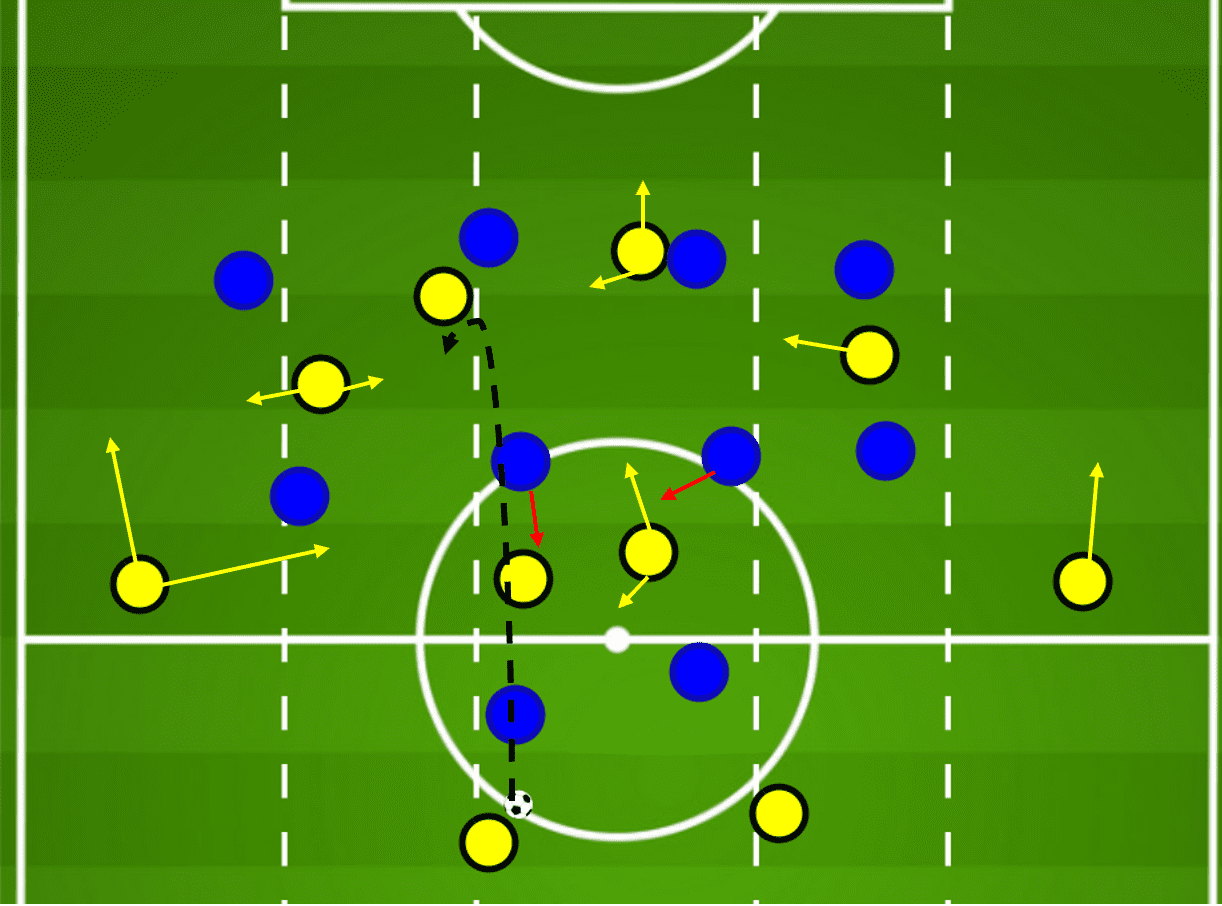
The space between the opposition’s midfield and defence is vital to ensure there is space to actually receive a pass from the striker, and so the central midfielders will often have the role of dropping deeper to offer immediate support to the ball, in order to drag the opposition midfield higher up the pitch, therefore leaving space behind them. Young Boys vary between a double or single pivot, and at times will only drop the ball near midfielder so that the other midfielder can also apply vertical support.
We can see an example here of this structure, with the centre back playing a direct pass into the striker. The full-back doesn’t offer himself as a short pass option, instead pushing on to provide width, and so the winger can drop into the half-space. This winger stays facing the ball, and his movement is triggered by the long pass then being played, where we can see he immediately turns. The direct pass is laid off by the striker into the space the winger is arriving into, and the winger’s body orientation allows him to play forward immediately.

Strikers’ runs in these situations are excellent, in that they often get between full-back and centre back, and so with the full-back occupied by the far winger who can maintain some width, spaces open up. Young Boys here are engaged in basically a 4v4 with the back line after a simple up, back, through movement.
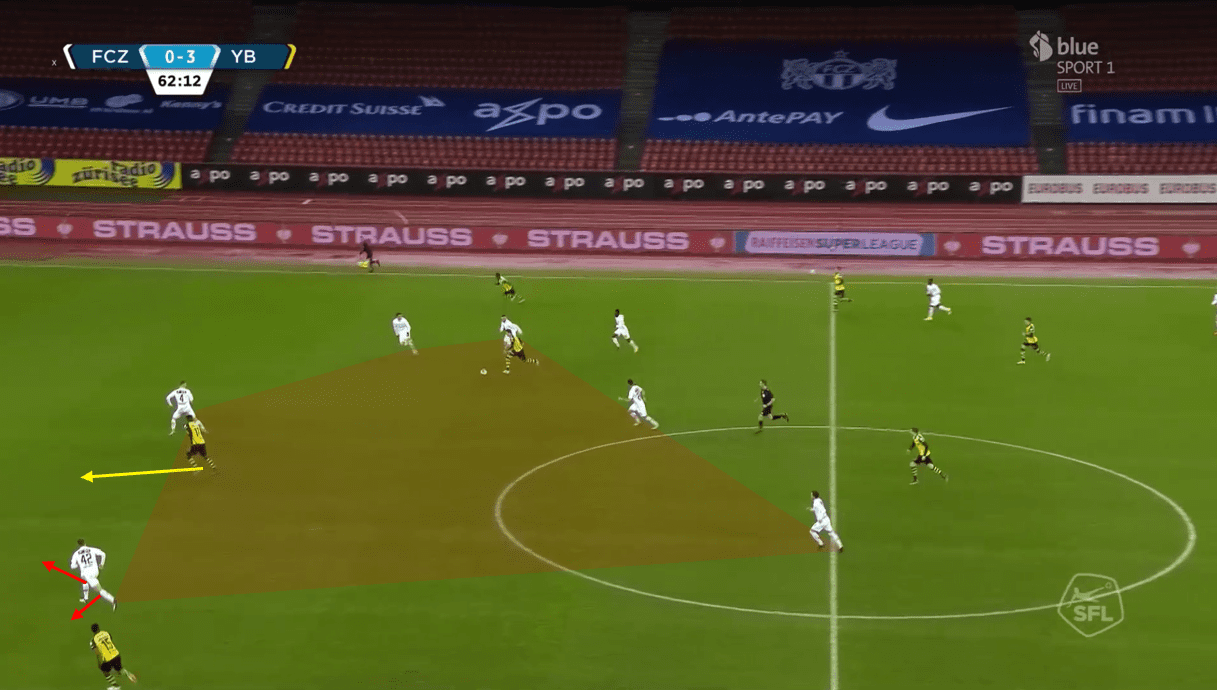
We can see in this example here that same shape, with Young Boys looking to impact the vertical compactness of Basel. The far central midfielder is actually so deep here they are off screen, but they quickly move back up to maintain Young Boys’ own compactness. Here we get a common variation though, with this time the winger providing the height of the attack, with the striker then dropping off behind the central midfielder to receive the lay back. We see the far winger moves narrower here, and so is a quick passing option for the third pass.
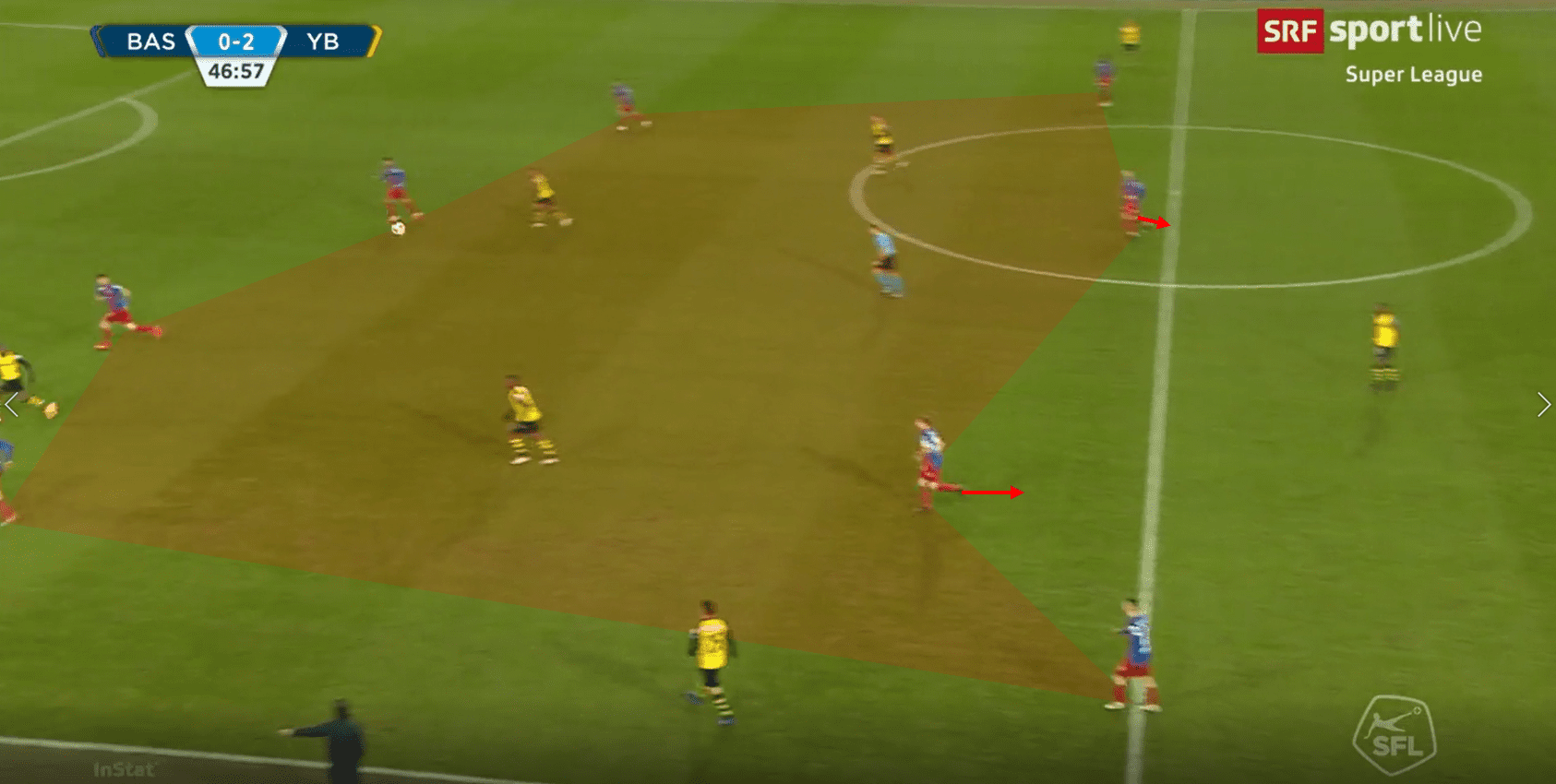
We can see an example from their match against St Gallen where the far winger moves very centrally to receive the ball, with the key being that this pass is a diagonal, meaning he can play forward or turn out, something we will discuss later also.
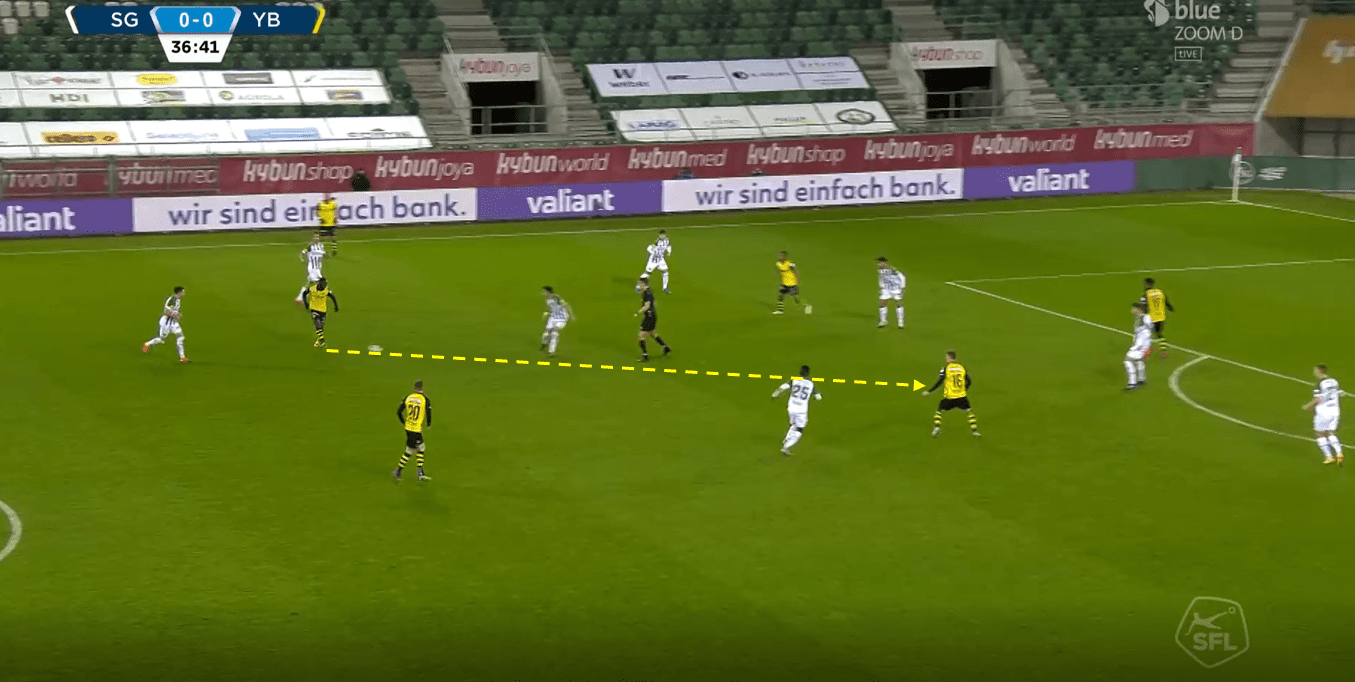
Their structure around long passes also facilitates third man runs often, and so you get several variations around this. One variation can be seen here, with the winger starting narrow and high and making a movement to receive a vertical pass. This movement drags the full-back out, and so the full-back is triggered to make a movement in behind. The striker can again receive and access the full-back for a third man run. Other common variations include: Full-back to striker to winger, and full-back to winger to striker.
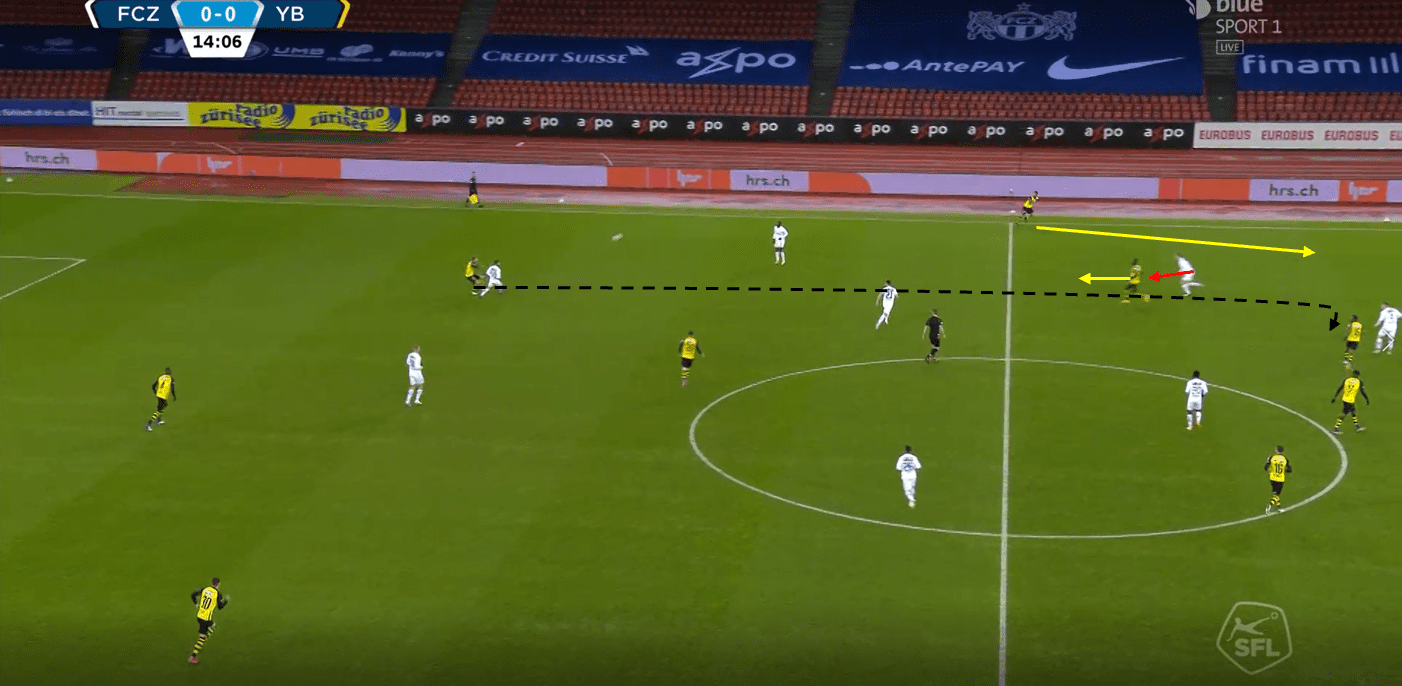
Making it easy to play forward immediately
A key concept behind any direct, vertical side is their ability to progress the ball forward quickly. The main ways to ensure the ball is progressed forward quickly and effectively are through body orientation, creating and occupying space, and support play, all of which are helped by Seoane’s philosophy implemented at the club.
Young Boys use the simple concept of dynamic space occupation really well, with the timing and frequency of these movements helping them to create and score really simple goals. We can see an example below of the timing having a big effect. Young Boys have possession out wide, and a clear space opens up inside. Rather than blindly sprinting into this space, the central midfielder holds his run, before then triggering the run because the ball is just about to be passed back into a player who can access the space. As a result, the opposition can’t react and mark him because he isn’t standing waiting, and he can also play forward or shoot immediately because he is running forwards while receiving the pass.
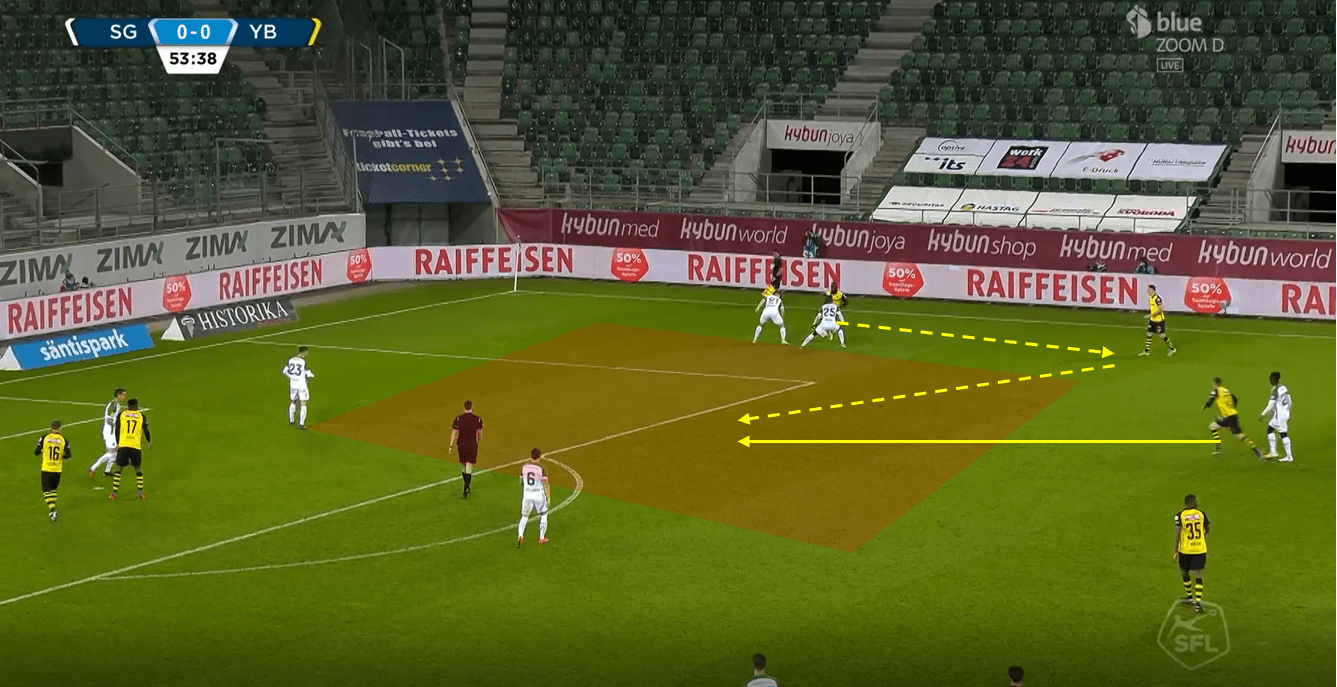
We can see an example of an excellent goal against Basel, where again those concepts of verticality and timing of support runs helps massively. The winger dribbles inwards and plays a pass into the striker. While the winger is dribbling to create the inside lane, the central midfielder triggers his run to support, and we can see that before the first pass is played, he is on his way into the space. The striker can receive and lay it off, and the central midfielder arrives into the space unmarked and ready to play forwards, leading to a goal.
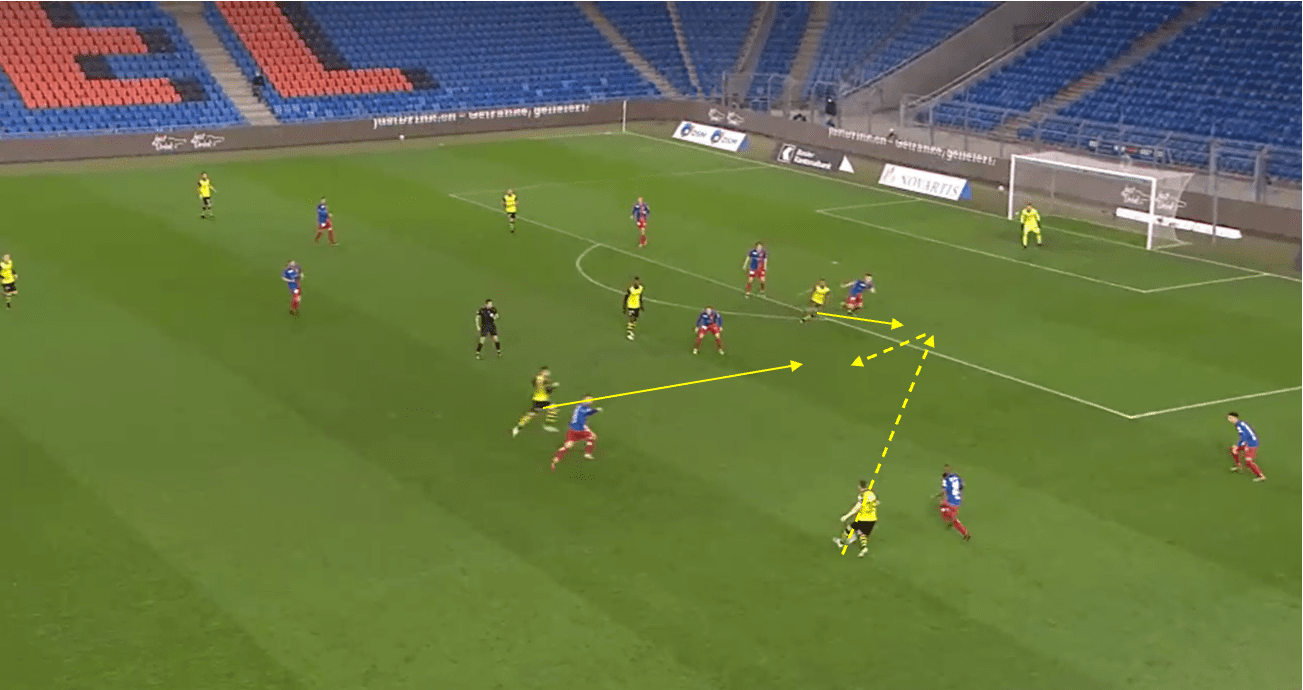
For another goal here, all it takes is a simple one-two pass and Young Boys get a free player in the box which leads to a goal.
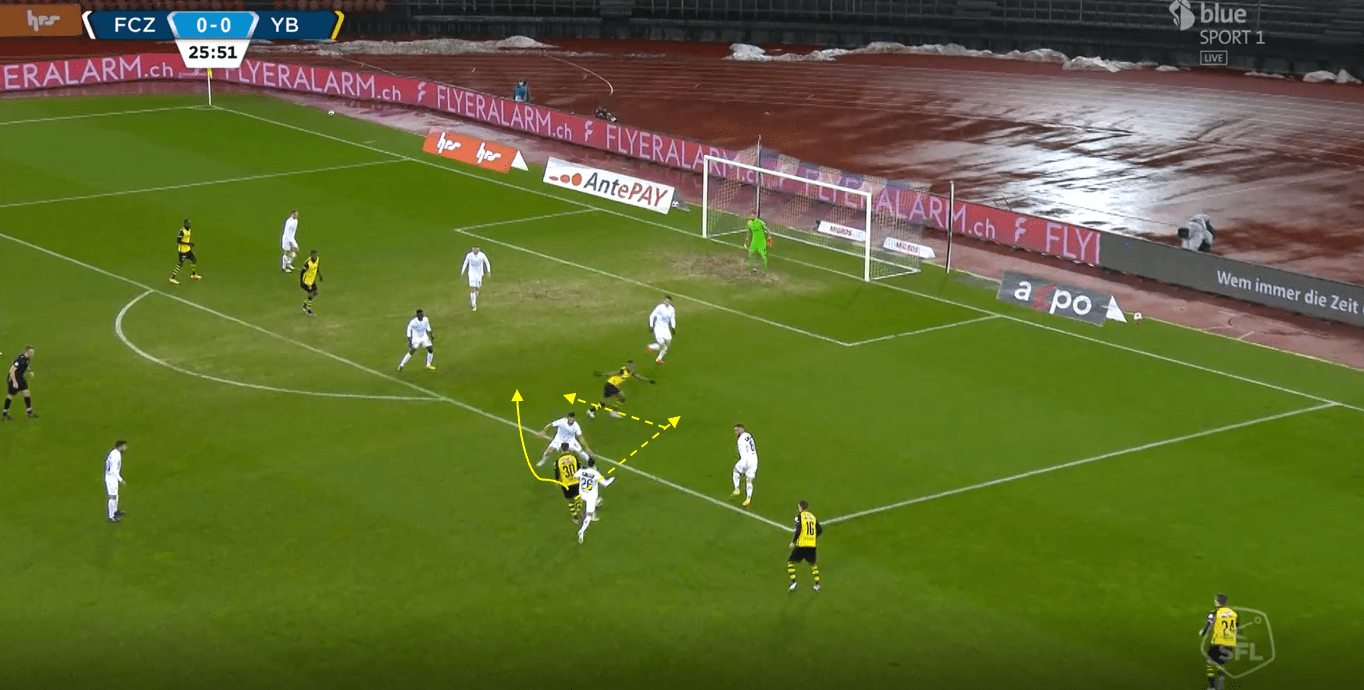
Despite some of the focus being around getting high up the pitch to provide a vertical option (or structural height to the attack), players will often drop off initially in order to either offer themselves as an immediate passing option, or to give themselves space to arrive into. We can see a good example of this with the winger in the half-space here, with the full-back high and wide again. The winger comes shorter, which means that when the ball is played out wide, they have a much better diagonal passing angle to receive the ball through, and so they can then arrive onto the ball and play forward.
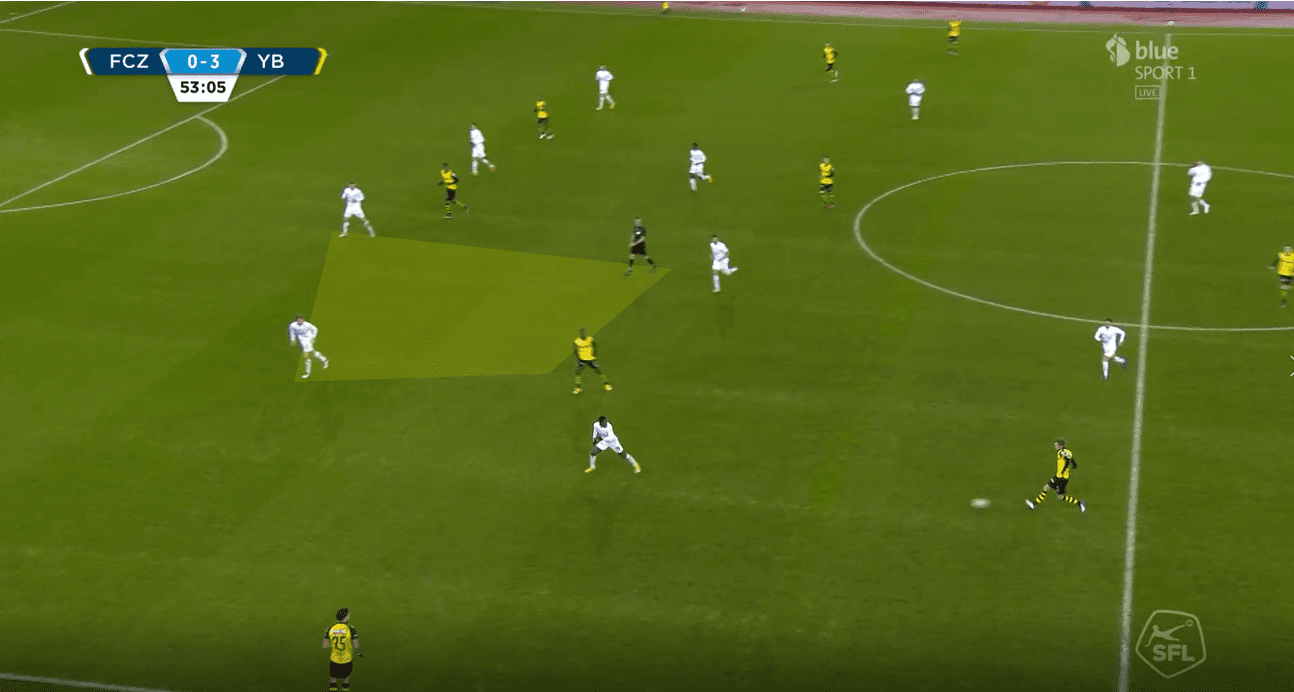
A lovely example of this can be seen here on the opposite side, with a winger arriving onto the ball on a diagonal, so they can control it in their stride and still be facing the goal. You then have two strikers on each centre back, with the far striker between full-back and centre back as usual, and so you have good passing angles to progress the ball further.
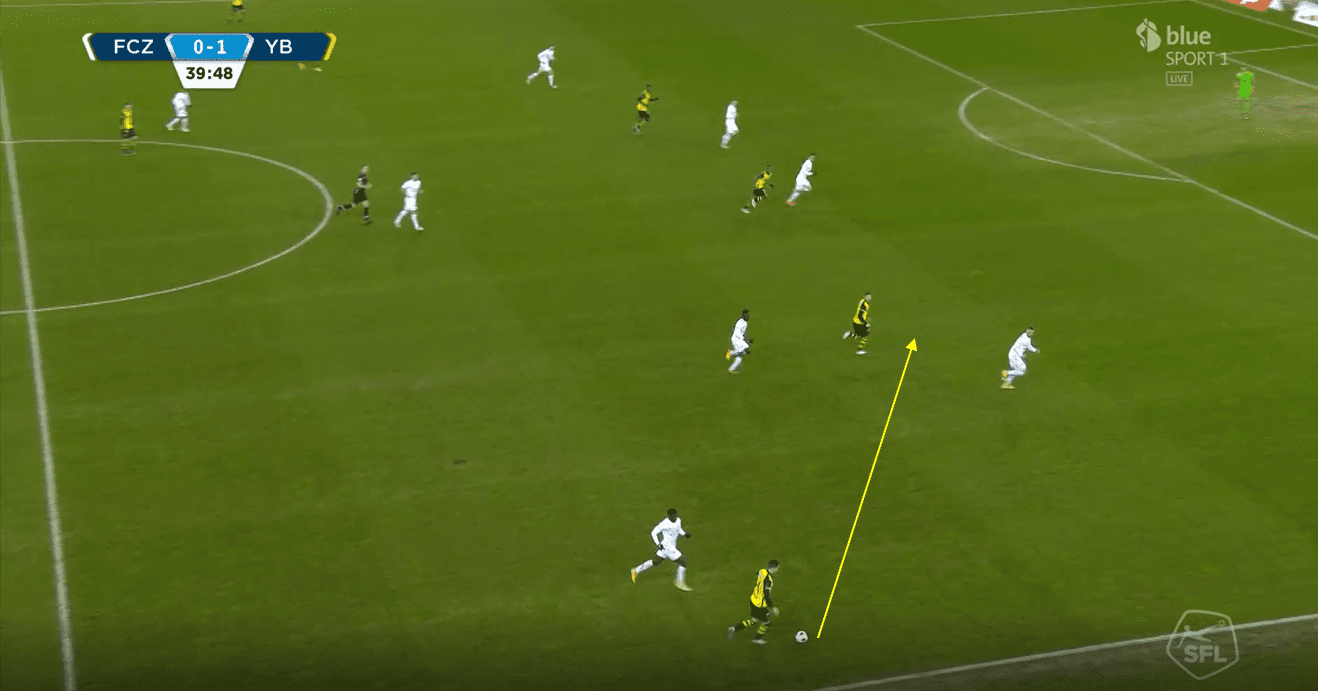
Centre backs and full-backs will often make such movements where they dribble outwards in order to access a diagonal lane, and this offers two advantages, with the first already mentioned around being able to play forwards immediately. We can see an illustration of a diagonal long (could also be along the ground) pass from the centre back here after a dribble to a wide area. The advantage this pass offers is that it becomes more difficult to allocate a player to pressure the ball receiver, as they are not just receiving at a straight angle. If you imagine this long pass is played into the nearby winger, it is clear who would press, however with the pass to the far striker, the movement sideways towards the ball causes problems. It also allows the receiving player to shield the ball using their body shape and play diagonally themselves. This dribbling from inside to out also looks to open central passing lanes, and so again this can be done with flat passes.
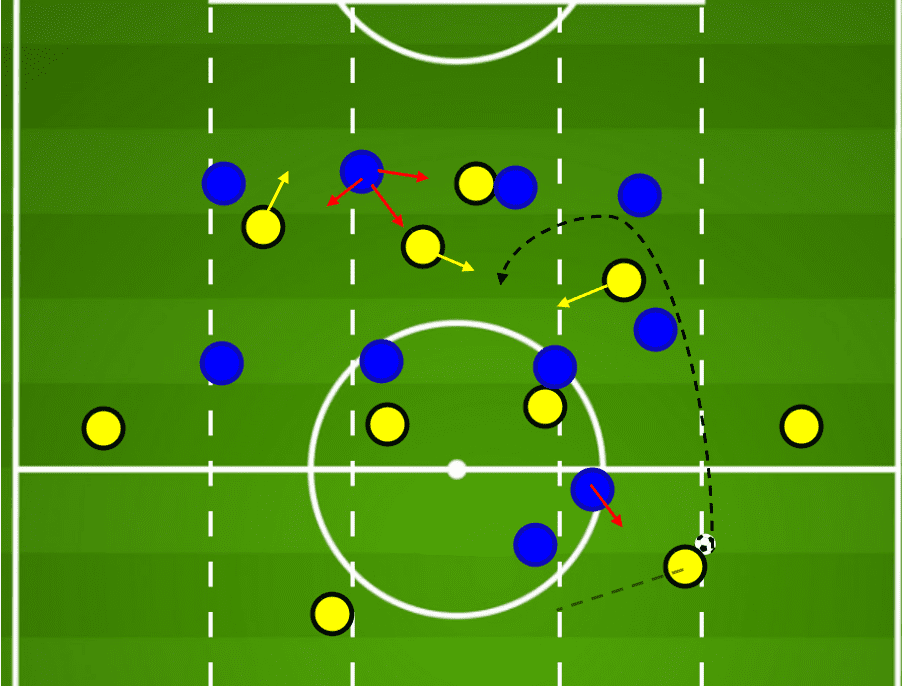
The Young Boys left back Jordan Lefort uses one two passes frequently with the winger in order to try and progress play, and again we see the pass is a slight diagonal which helps for the receiver to play the ball back inside. Their narrow structure as a whole, as well as movements like this contribute to them also being a cross heavy team, with them leading the Super League in crosses per game (23). They are able to load the box using their narrow wingers and two strikers, and so it is fair to say the vast majority of their goals come from passes in behind, crosses and direct combination play.
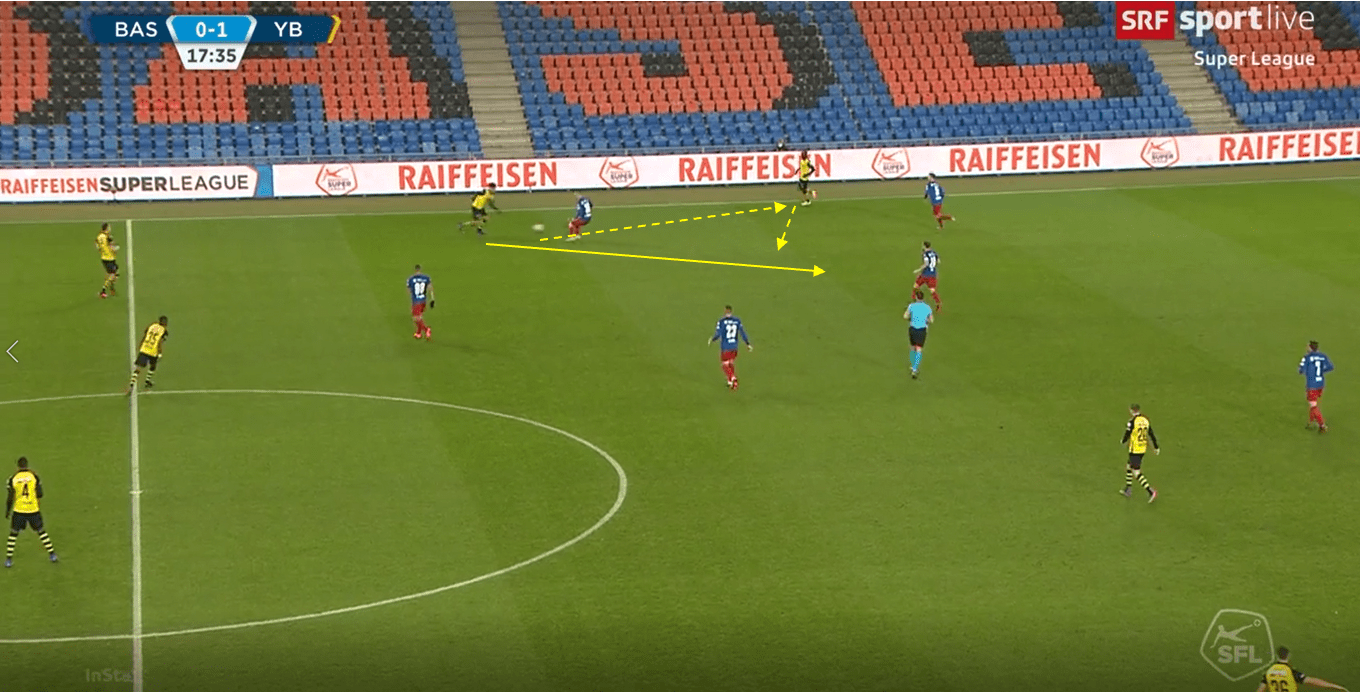
Defensive transitions
As alluded to by their good vertical support, Young Boys’ structure allows for good counter-pressing and coverage of second balls from direct passes. Their typical structure of a full-back high and two deeper central midfielders allows for good coverage and is also helped by a narrow far side winger, and a deeper narrow winger at times. Here the ball side winger is involved in challenging for the ball, but Young Boys still have the vertical cover from the central midfielders and full-backs, as well as immediate vertical cover from the far winger. If you go back to previous examples showing a winger dropping off to receive a pass, you can see how they can aid the counter-pressing structure if the opposition win the first contact.
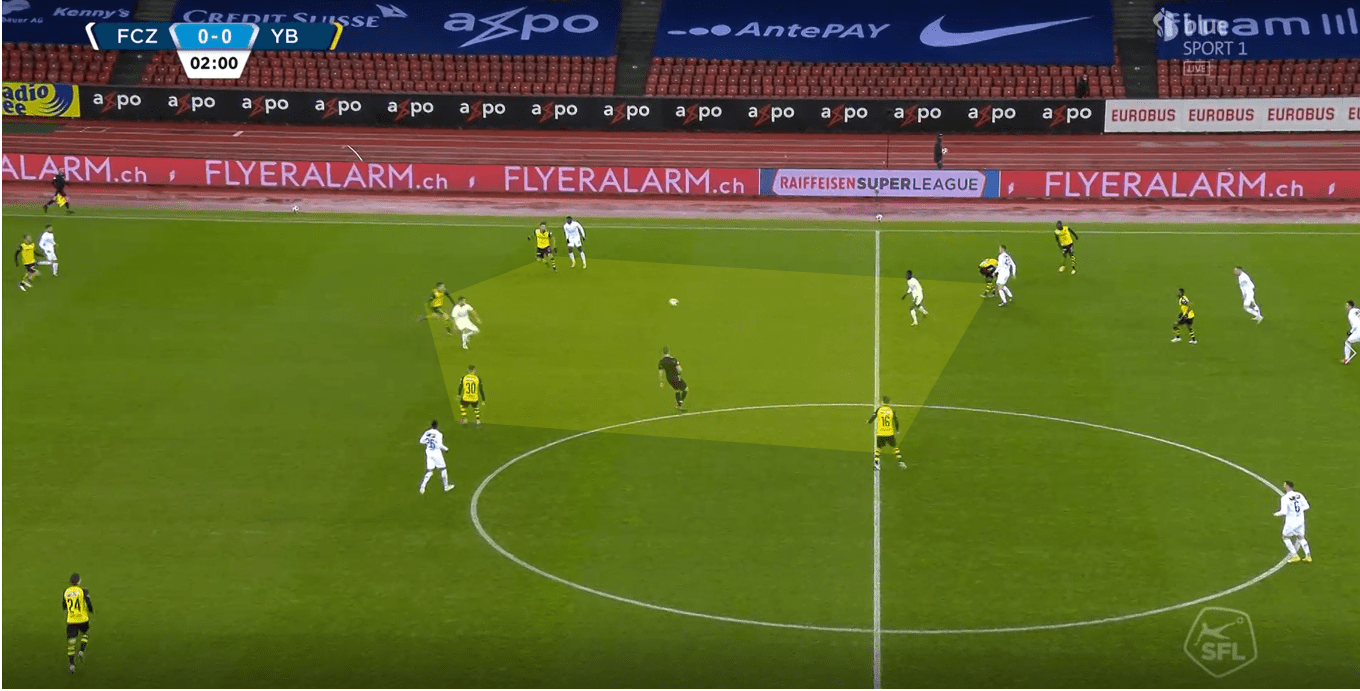
The 4-4-2 pressing system
Seaone sets his side up to press in the same 4-4-2 system, with the system again having some interesting features. They are not an ultra-aggressive high pressing team, and instead usually set up in more of a mid-block, as we can see here. Wingers stay narrower and protect the inside lane while preparing to press the full-backs, while the strikers work hard to press and cut central angles. The central midfielders are option oriented, and so here we see they just press the opposition midfielder in front of them.
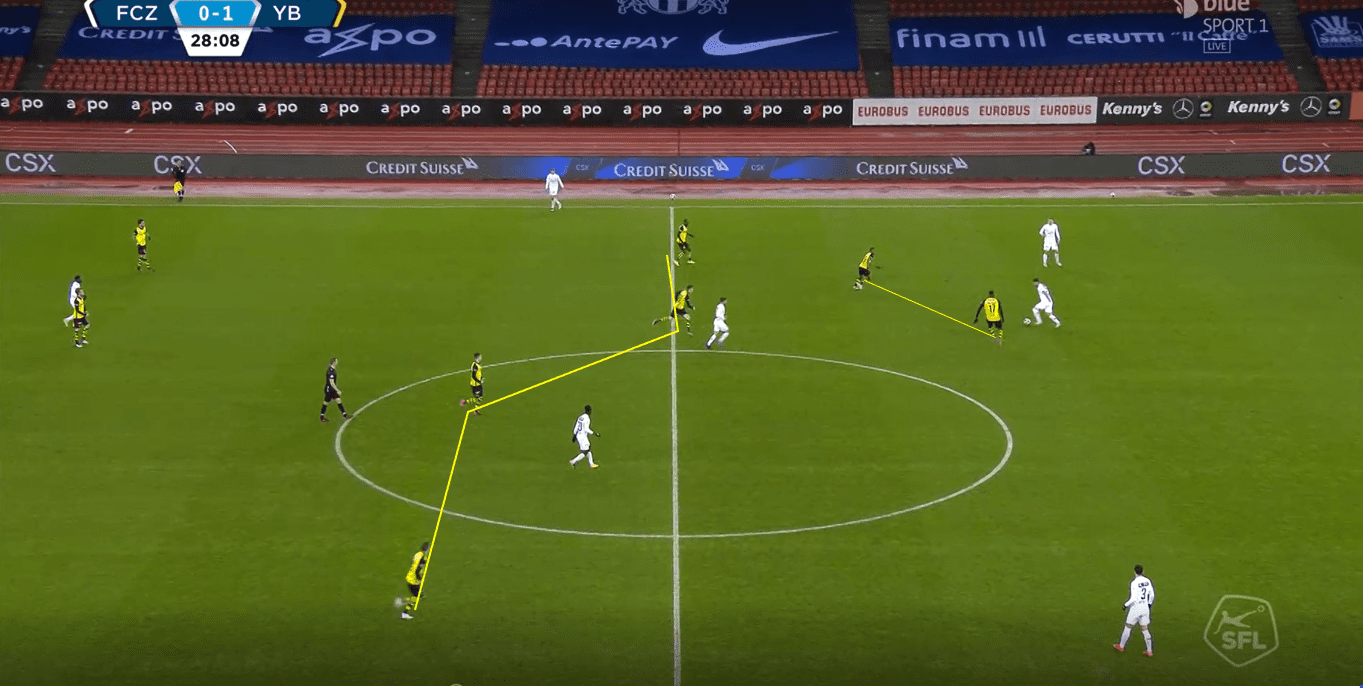
Within the mid-block the strikers generally do a good job of using their cover shadows and pressing at good angles to help their central midfielders, and we can see an example below where the striker’s pressure on the ball and angle helps to prevent a vertical pass being played into the half-space.
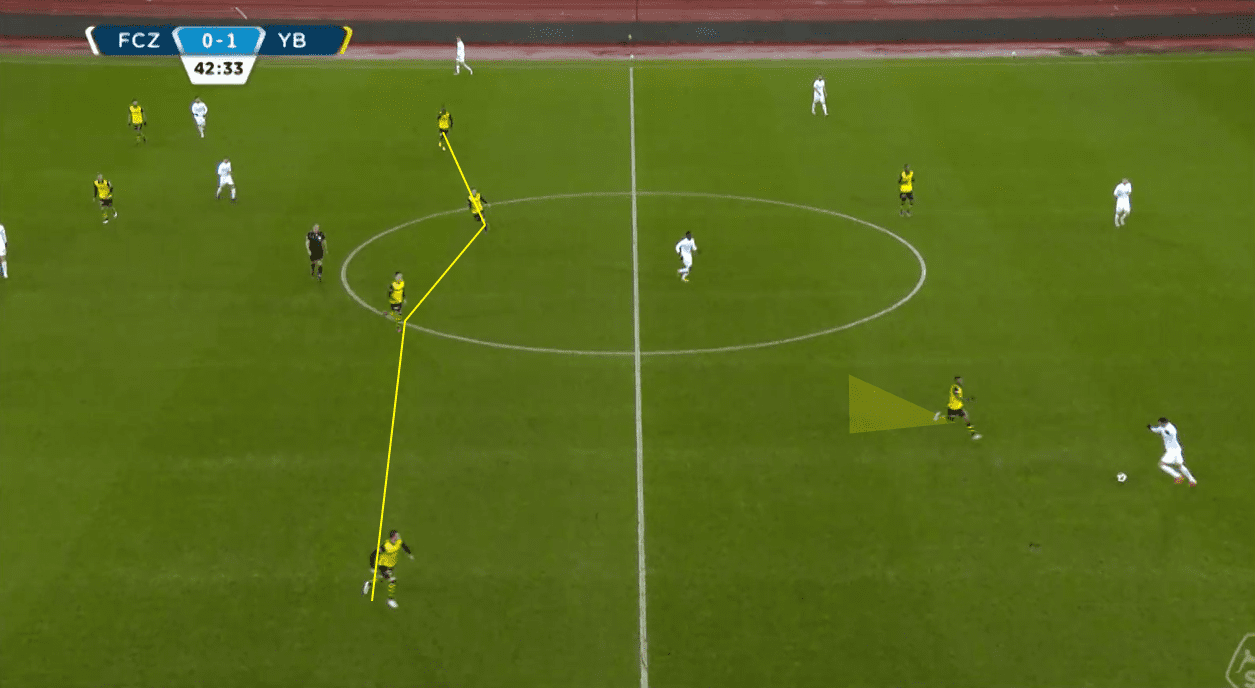
The natural disadvantage of the 4-4-2 system is the fact that it can be overloaded in central midfield, or it can be stretched as shown in the previous example. Young Boys work to manage or nullify overloads using these cover shadows, and with option-oriented pressing in central midfield. We can see an example here of this, with their option-oriented pressing often meaning they move into a 4-3-1-2 structure, with one central midfielder moving higher to press a single pivot. The central midfielder pushes on, but a midfielder then becomes free in the half-space.
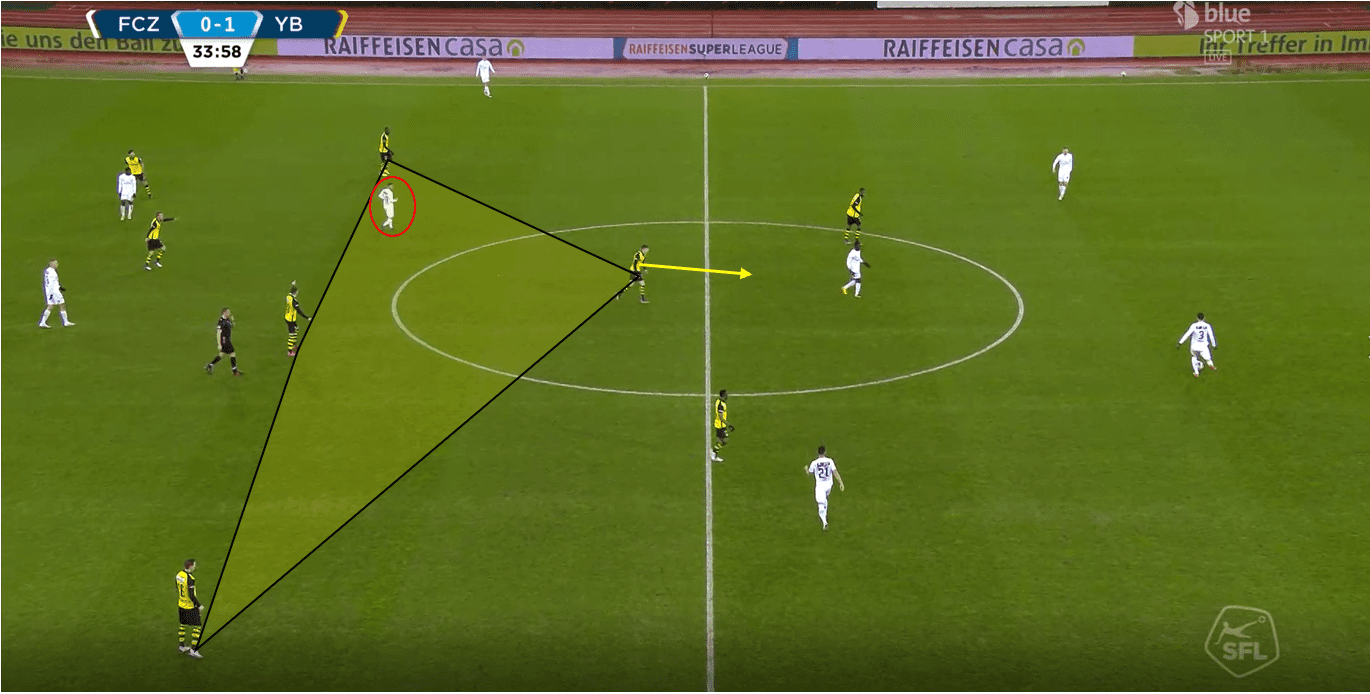
When the opposition switch the ball to access this overload, we see the central midfielder now drops off to cover the nearest and most threatening ball progression option, while the striker again keeps a good pressing angle to cover the half-space with his cover shadow. The far striker can then press across to mark the deeper free midfield player.
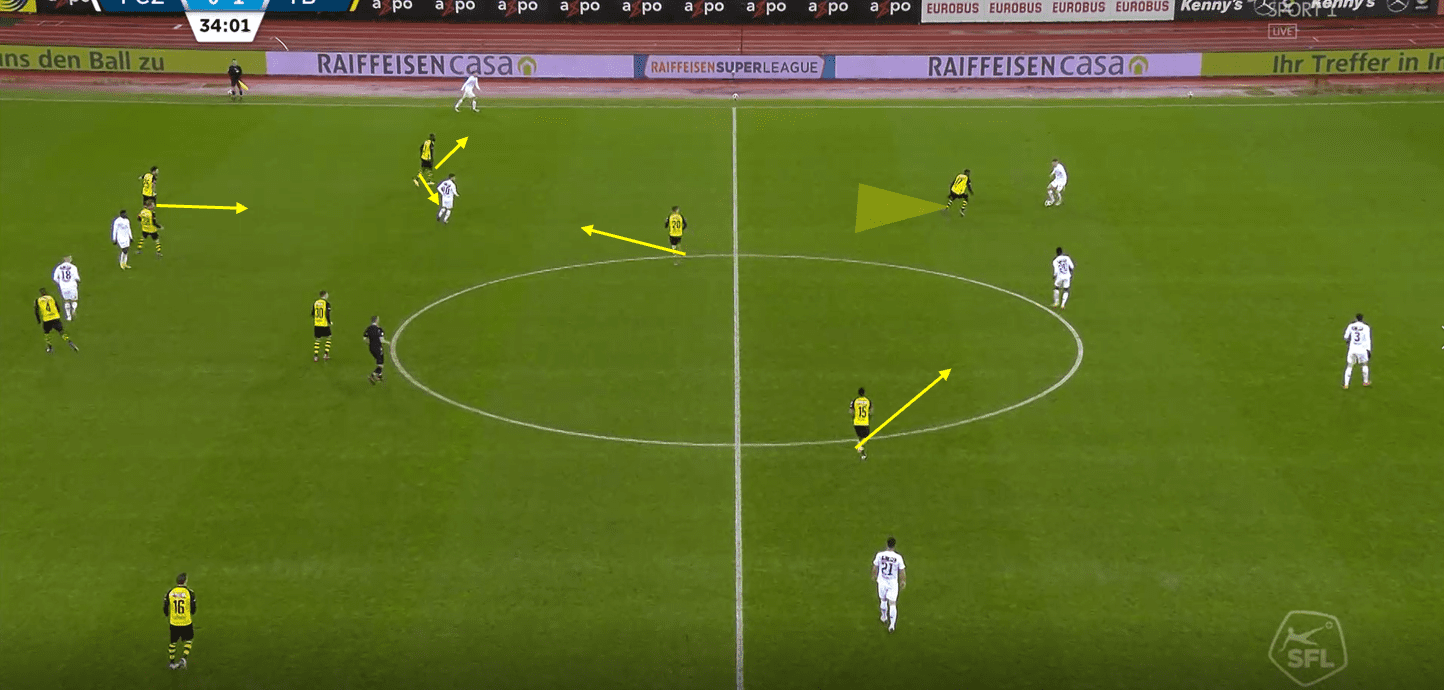
Here we see the overload in central midfield is nullified by just trying to stay in between both options and jumping to one option once it is clear they will try and receive the ball. This occurs higher up here, and we see the striker’s pressing angle again helps to make the option-oriented pressing of the midfielders easier, as the opposition’s build-up becomes more predictable.
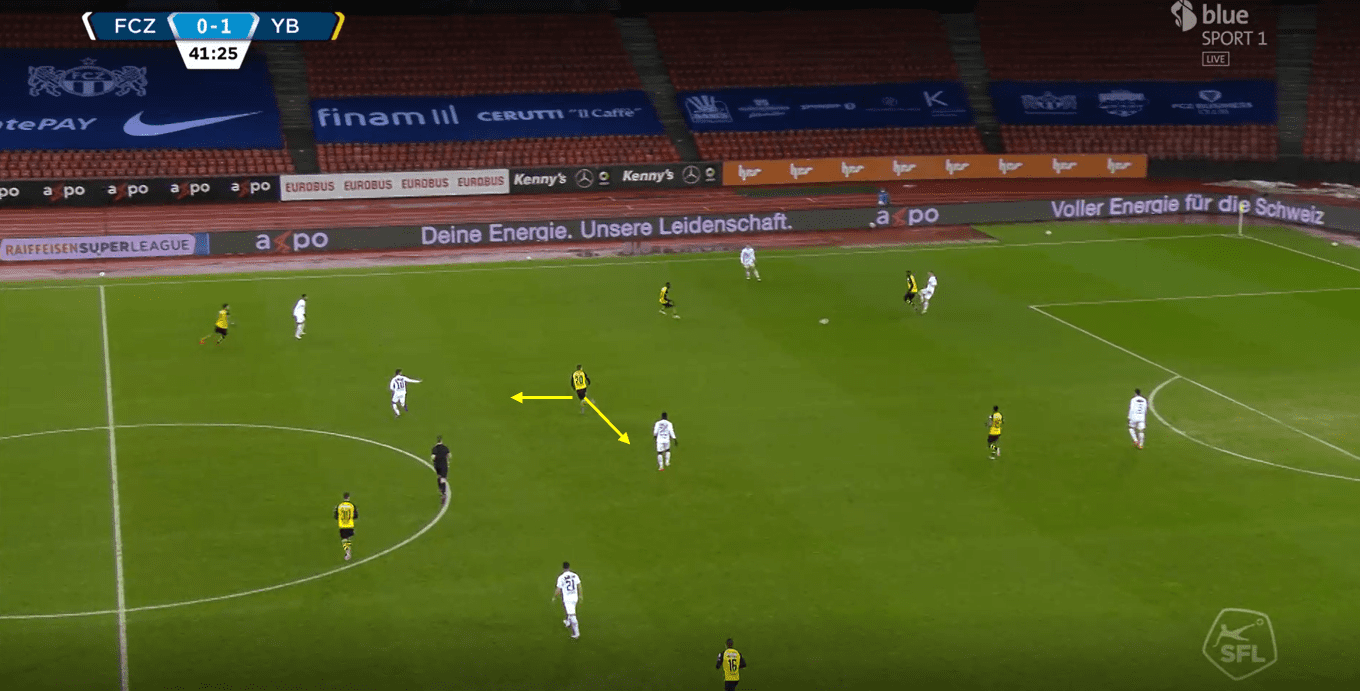
We can see another example here where they adjust to an overload, with the higher central midfielder following one player before jumping to the next after they have been accessed, with the winger then prioritising central compactness and moving inside.
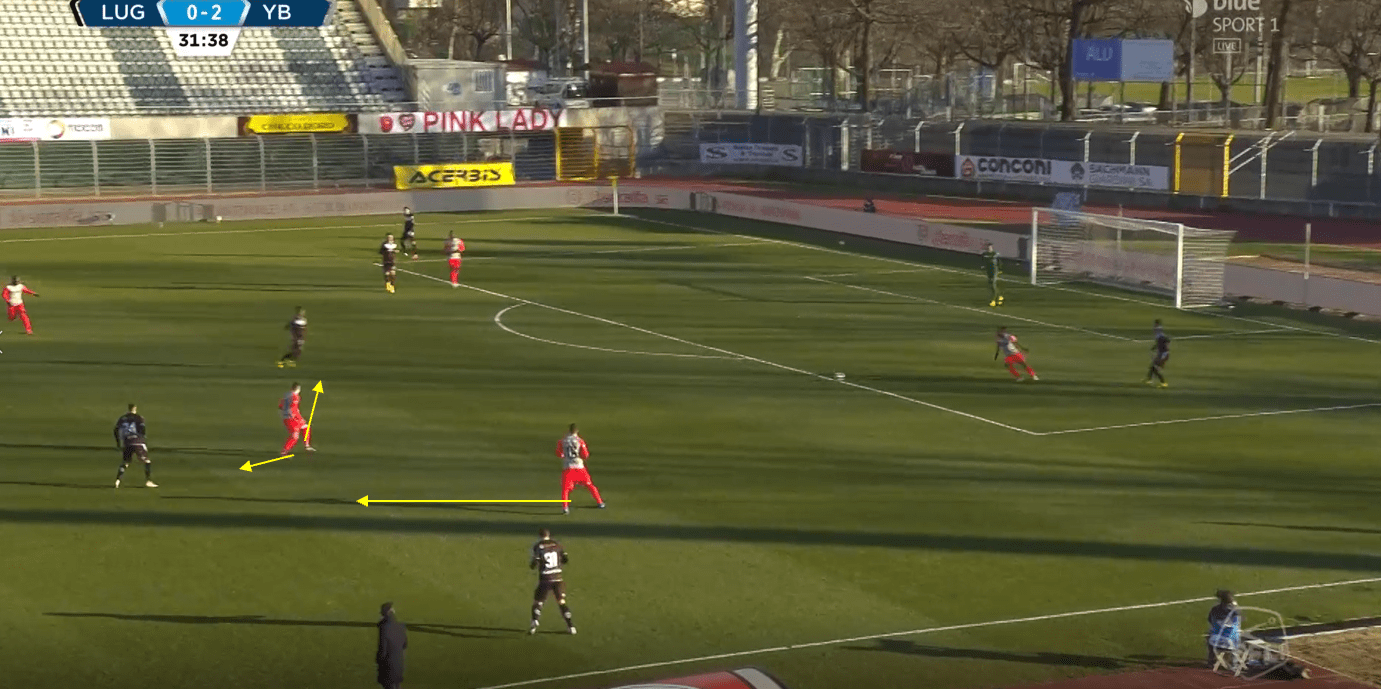
Here we can see a clear image of their 4-3-1-2 shape here from a goal kick. The ball is shown into the left half-space into a free player, who can be pressed from behind by a winger. The higher central midfielder back presses to cover the run of the receiving player after they have passed wide, and the full-back and centre back shift into wide areas to press the ball, leading to a throw. Seoane seems to like to have cover in front of the back four as a principle, and so this 4-3-1-2 shape is very common for Young Boys.
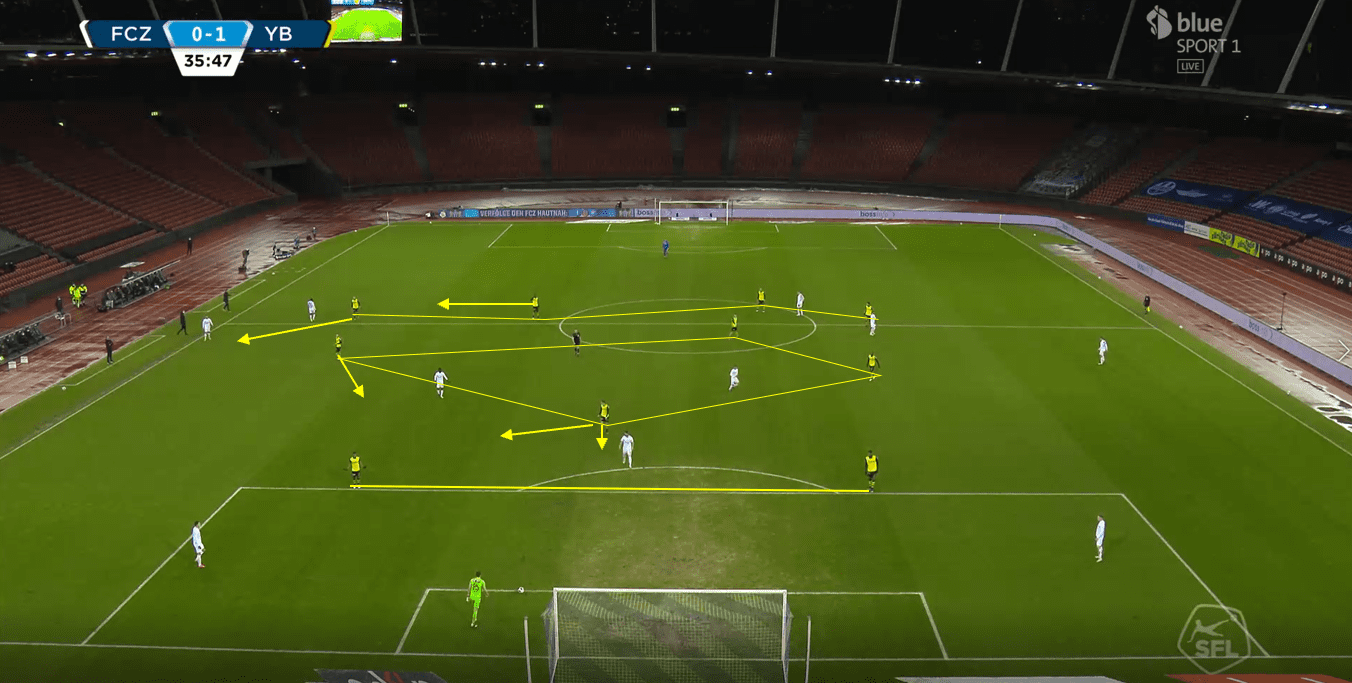
A common adaptation used by Seoane is to have the full-back press in the half-space from a narrow position, with the winger then covering the wide lane. Young Boys do not want the winger to engage against a back three (something they face often), and so they can maintain coverage of the half-space through the full-back, and coverage of the wide lane through the winger. Lots of teams do this the other way around, which leads to wingers being more passing lane oriented and reliant on the spacing between themselves and the central midfielder, which is easier to manipulate than a player oriented on this zone.
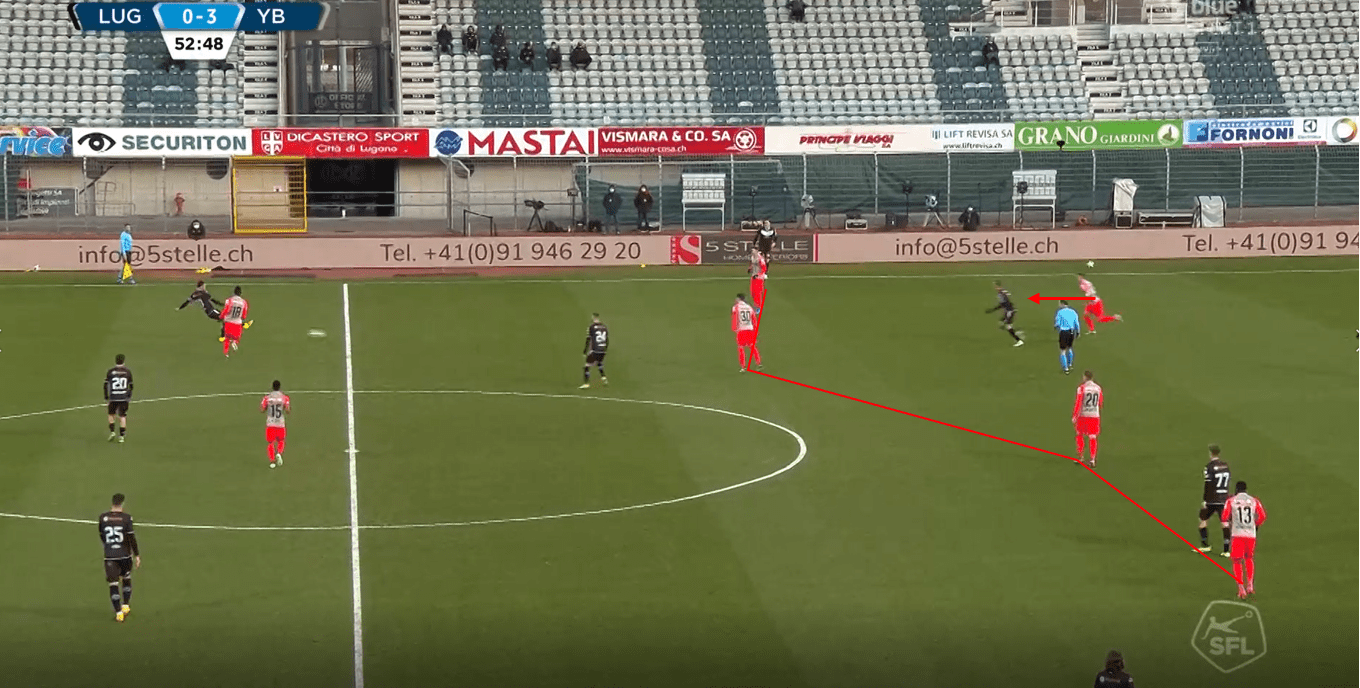
Crucially for their pressing system, it allows for an excellent rest offence, which describes the shape they take up out of possession in preparation for a counter-attack. They scored an excellent goal against Zürich that summarises it well, with this structure seen here where they have just won the ball. The ball is pressed out wide by a winger and then recovered by the full-back, who can immediately play into the central midfielder. The opposition’s full-back has moved forward to support the initial pass, and so the Young Boys winger can get in behind. They naturally have two players up against the centre backs, and we see the far striker is in that position between full-back and centre back again ready to receive the ball. The nearby striker drops to receive, turns and plays the ball into that lane, and the far striker scores. A seven second counter-attack goal.
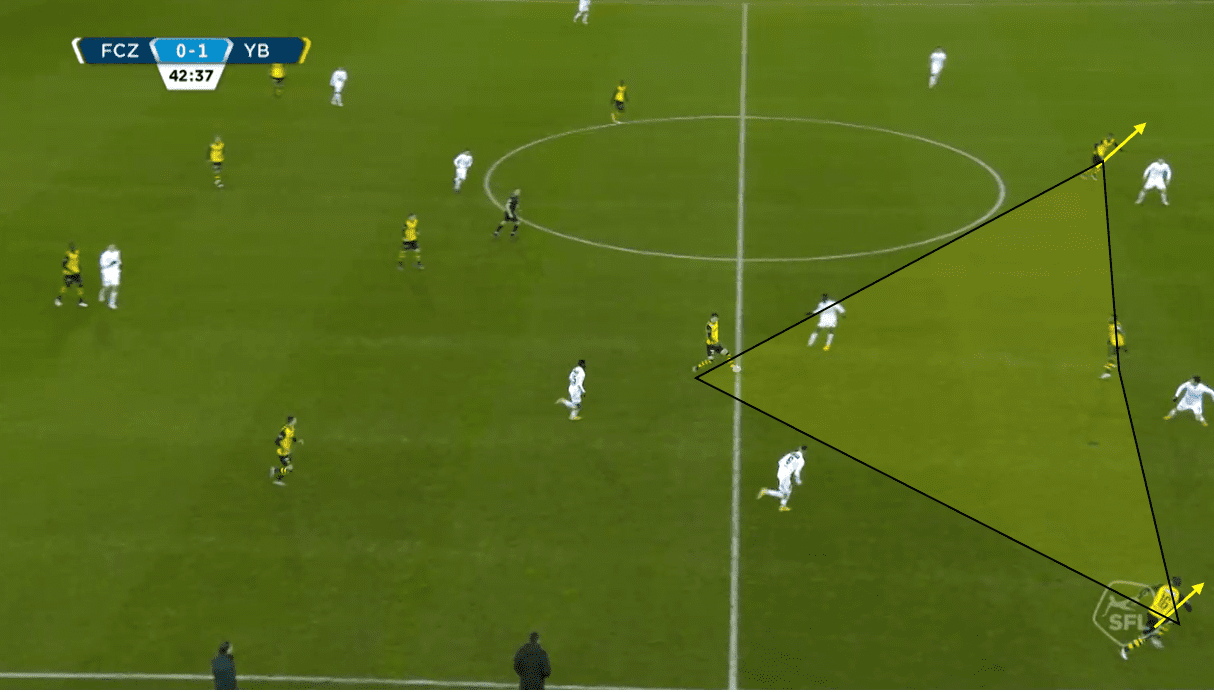
Conclusion
Gerardo Seoane is rightfully starting to be considered as inevitable in a top five league soon, and his success with Young Boys this season has put him in good stead for a role if he wants it. His direct, dynamic philosophy offers a counter to possession-based football, and his clear playing philosophies make him an in-demand coach for teams who want to play in such a way. Borussia Mönchengladbach are one such team who pride themselves on this style of play, and if Seoane was to take over the role, it is unlikely that he would need a large influx of players, with players like Marcus Thuram, Denis Zakaria and Matthias Ginter all suited to the style of play. He would also add the benefit of speaking six languages, and of being Swiss, like the spine of the Gladbach side is at the moment.
Seoane though can only be concentrated on the rest of the season, and Young Boys have a mouth-watering tie against Ajax in the Europa League coming up, and this will certainly be an interesting test out of possession for Seoane against a more positional play based side who will look to overload or exploit that central midfield area. Even if they do not come through that tie, I would expect to see Seoane linked with a move in the Summer and would love to see what he could do on a bigger stage.

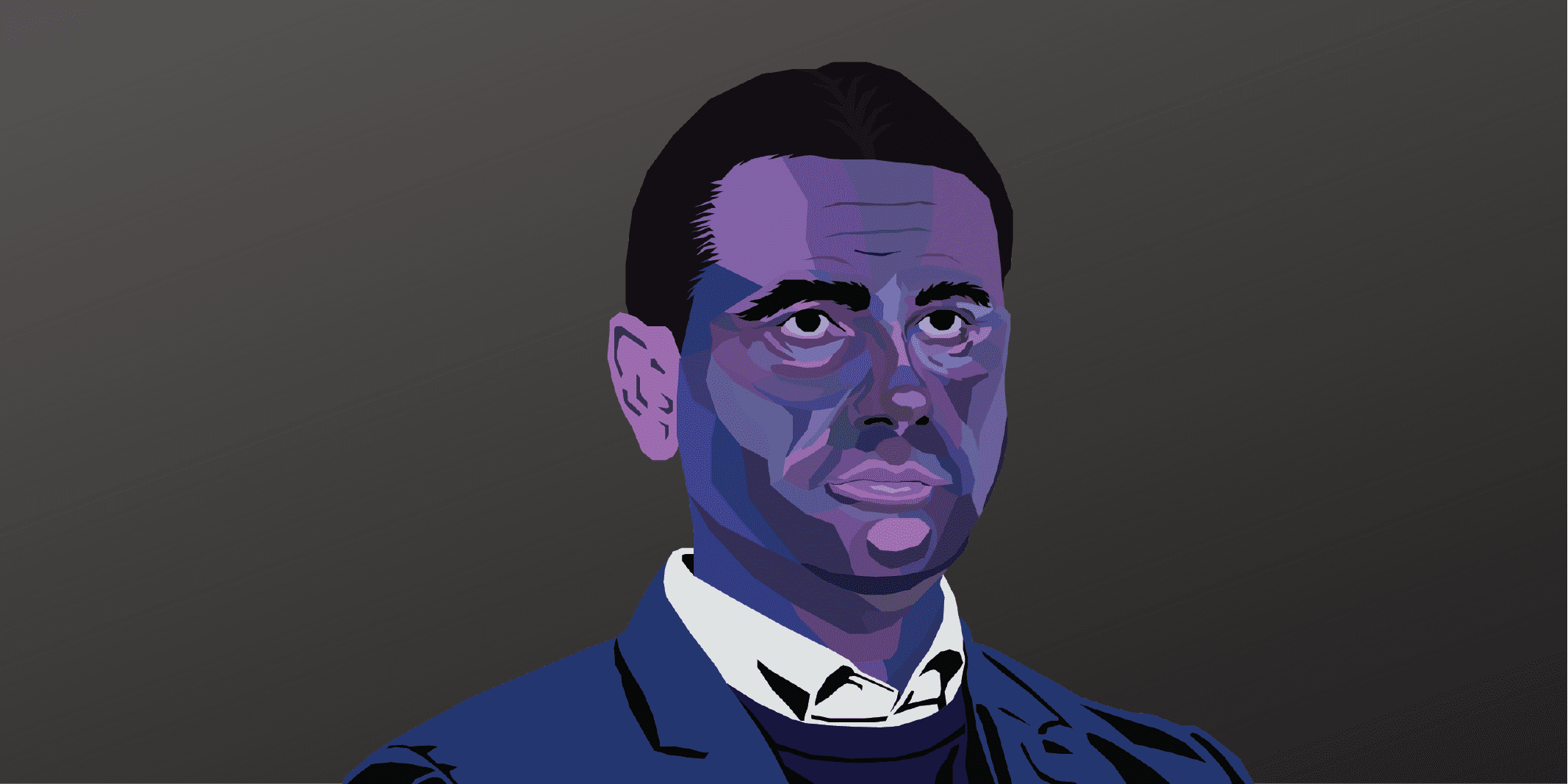



Comments